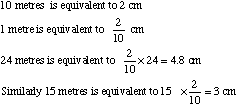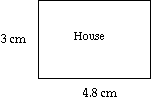 When doing constructions, accuracy, clarity and neatness are essential.
When doing constructions, accuracy, clarity and neatness are essential.
The common constructions include: Bisectors of lines and angles, perpendicular lines, parallel lines, circles and polygons
Acceptable methods of construction include ruler and compasses, paper folding and using tracing paper.
The following constructions can be done using a ruler and compasses only.
Perpendiculars and Bisectors
Bisector of an angle
|
To bisect angle ABC: Step 1 Draw an arc, centre B, to cut AB at P, and BC at Q. Step 2 Draw equal arcs, centres P and Q, to intersect at R. Step 3 Join B to R. |
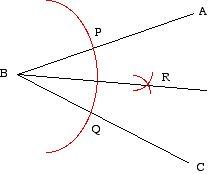 |
Perpendicular bisector of a line (called a mediator)
|
To bisect AB at right angles: Step 1 Draw equal arcs, centres A and B, of radius more than half of AB to meet at P and Q. Step 2 Join P and Q
|
 |
Parallel lines
|
To construct a line parallel to AB passing through C. Step 1 Mark a point Q on the line AB. Step 2 Draw arc, centre Q, radius QC, to cut AB at P. Step 3 Draw arcs with same radius(QC), centres C and P, to intersect at R. Step 4 Join C and R.
|
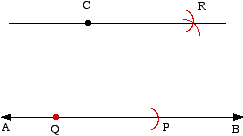 |
Perpendicular lines: Method A (C not on AB)
|
To construct a line perpendicular to AB passing through C: Step 1 Draw arc, centre C, to cut AB twice at P and Q. Step 2 Draw equal arcs, centres P and Q, to meet at R. Step 3 Join C and R. |
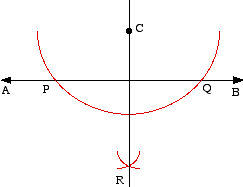 |
Perpendicular lines: Method B (C on AB)
|
To construct a line perpendicular to AB passing through C: (a) Draw equal arcs, centre C, to cut AB twice at P and Q. (b) Draw equal arcs, centres P and Q, to meet at R. (c) Join C and R. |
 |
Constructions from Given Data
Some shapes and figures can be drawn from given data such as lengths and angles using ruler and protractor.
|
Circle Draw a circle of radius 2 cm.
Triangle: Method A Draw a triangle ABC with sides of lengths 2 cm, (a) Draw one of the sides 4 cm with ruler (label AB)
Triangle: Method B Draw a triangle PQR with sides PQ = 5 cm (a) Draw a line PQ of length 5 cm. |
|
Triangles: Method C
|
Draw a triangle XYZ with angle X = 45° angle Y = 75° and side XY = 6 cm (a) Draw the line XY of length 6 cm. (b) Draw an angle of 45°at X. (c) Draw an angle of 75° at Y. (d) Z is the point where the lines intersect.
|
 |
Quadrilateral
|
Draw a quadrilateral ABCD, with angle A = 110° and angle B = 80° and sides of AD = 4 cm, BC = 5 cm and base AB = 6 cm. (a) Draw the line AB of length 6 cm. (b) Set compasses to 4 cm and draw arc on A. (c) Set compasses to 5 cm and draw arc on B. (d) Use protractor to draw angles of 110° and 80° on A and B to find C and D. (e) Join the four points. |
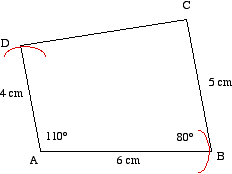 |
Scale Drawing
A scale drawing of an original is a plan where all of the measurements are in the same ratio as the corresponding measurements in the original. Examples of scale drawings are maps and house plans.
e.g. The external measurements of a rectangular house are 24 m by 15 m. Draw an accurate scale drawing of the house using a scale of 2 cm =10 m or a scale of 1 to 500.
|
Longest side:
Shortest side: |
|
|
Locus
A locus is a set of points or a path that satisfies a rule or set of conditions.
A locus can be seen as the path a point takes in satisfying these rules or conditions.
Examples
|
Find the locus of a point P equidistant from a point A. Answer: This locus is a circle. Each point is the same distance from A.
|
 |
|
Find the locus of a point P equidistant from two points A and B . Answer: This locus is a straight line bisecting AB at right angles. Each point is same distance from both A and B.
|
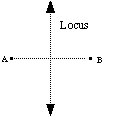 |
|
Find the locus of a point P equidistant from a line k Answer: This locus is two lines both parallel to k and the same distance from it. |
 |
|
Find the locus of a point P equidistant from two intersecting lines m and n. Answer: This locus is the angle bisectors of the two angles formed by the two lines. |
 |

